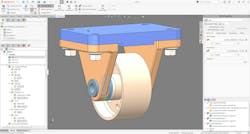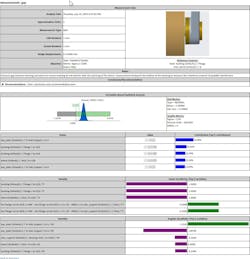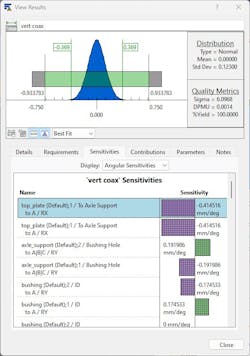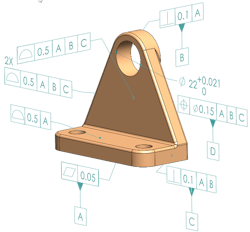Design Efficiency Through Mechanical Variation Management
By addressing mechanical variations early in the design process and encouraging clear communication among team members, design teams can improve product quality, cut costs and bring their innovations to market faster. Integrating advanced tools and educational resources supports accurate tolerance modeling and informed decision-making at every stage of development.
Take Sigmetrix, for instance—a software solutions provider that helps users achieve robust designs through tolerance analysis and the correct application of GD&T. During 3D Experience World in Houston, Kyle Heythaler, a senior business development manager at this Gold partner of Dassault Systemes, said during a presentation, “Ignoring mechanical variation early in design leads to costly rework during validation, prototype and pilot stages.”
Traditional methods for handling mechanical variation, such as stacking tolerances in Excel, can fall short in providing accurate or timely representations of potential issues. “Companies still say this takes too much time,” Heythaler said. “It’s still not going to show what’s going to actually cause the problem and avoid the real production issues,” he said.
Research indicates that more than 70% of companies encounter production problems stemming from tolerancing issues, he noted. Many seek to address post-shipment problems, but as he pointed out, “Designs are thrown over the wall and then manufacturing inspection has to deal with this down the line.”
Early Intervention in Design Stages
Heythaler spoke of the tools and educational resources that can help design teams create accurate tolerance models that predict real-world behavior more effectively than traditional spreadsheets.
Machine Design reached out to Sigmetrix to see if they could elaborate about how CETOL6σ integrates with various CAD platforms and what advantages this integration provides engineers.
Stephen Werst, director of customer success and product strategy, explains that CETOL6σ is integrated as an add-on application for Solidworks, Creo and most recently Siemens NX. He said there are several benefits of such integration, including letting the user work in an environment with which they are already familiar for manipulating the models, selecting features, creating cross-sectional views, etc. “Basically, it minimizes the learning curve of adopting the new solution,” he said.
Supporting additional options to save the analysis data within the CAD models in addition to separate files as well as importing PMI and assembly constraint information are also beneficial.
For Creo and NX, actually being able to automatically create PMI in the CAD models based on tolerances first defined in CETOL is also a positive, Werst says. “We wanted to do the same for Solidworks but experienced some issues in their API,” he noted. “Work is currently underway to understand whether those issues have been addressed so that we can extend this same functionality to Solidworks.”
Mathieu Fourcade, strategy and business development director for Solidworks at Dassault Systemes confirmed: “For more than 20 years, Solidworks has fostered a vibrant partner ecosystem, and we work closely with our technology partners around the world—like Sigmetrix—to ensure our clients get the most out of our solutions. We’re aware of the challenge they have encountered and are actively engaged to help them resolve it.”
“One significant benefit of this capability is to let engineers define their variation models early in the design process—use the tool to define Datum Features, Datum Reference Frames, the types of controls needed and the correct tolerance values to achieve the system-level objectives before adding any tolerance information in their CAD models,” Werst said.
“Companies...will now address things earlier in the concept stage with R&D,” Heythaler said. This approach allows designers to analyze simplified variations before finalizing geometry or manufacturing processes, facilitating faster exploration of concepts and robust data insights. Engineers can assess multiple design options rapidly and eliminate those that are infeasible. Continuous linkages to CAD allow for consistent updates and insights throughout the design process, which makes it easier to identify potential issues.
Heythaler says that an advantage of an early intervention strategy is that it allows for a more iterative design process. “By catching issues early, teams can make more informed decisions before committing to manufacturing, which reduces errors and costly adjustments later.”
Take Phillips Medisize (formerly Philips Plastics) in Hudson, Wis., for instance. Prior to implementing CETOL6σ, the company used customized Excel spreadsheets for doing their 1D tolerance stacks for years. As their customers’ designs became more complex, they were increasingly asked to perform a higher level of analysis than they could continue to offer with a spreadsheet-based approach.
According to a senior design engineer at Phillips Medisize, using CETOL in their design process has helped the company be more confident in their design tolerances, reduce the number of prototype iterations, maximize production yields and support their continuous improvement effort. “Our customers understand that a little more time and effort spent up front can save a lot of time and money down the road in tool rework, product redesign, validation delays and production downtime,” he said.
Prototype Analysis and Challenges
While physical prototypes are an important aspect of product development, their limitations—such as lack of statistical significance and the inability to accurately represent real manufacturing conditions—can lead to misleading conclusions, Haythaler notes. Traditional prototypes often produce “idealized assembly, rather than a realistic one,” which he says can skew understanding of the product’s actual performance.
When asked what the most common challenges engineers face when performing tolerance analysis, Werst says the biggest challenge they face when understanding how dimensional variation will impact their designs is having the time to formulate the complex mathematical equations describing the 3D interactions between imperfect parts.
“Given the complexities in said equations, there are numerous opportunities for mistakes,” Werst said. “There is also an inherent complexity in understanding how the various distributions of the random variables associated with each of the input dimensions combine through the complex equations. Because of this, most typically simplify the problem definition to 1D treatment where the math becomes much easier. They also simplify the statistical calculations by using the Root-Sum-Squared (RSS) technique.”
He continued: “While many problems can properly be modeled with 1D analyses, certainly within the error associated with the input assumptions, it’s also quite common for engineers to overlook potentially significant 3D effects.” He says that CETOL removes this burden of formulating the complex calculations from the engineer so that they can understand both simple and complex interactions with the same fundamental workflow. “When demonstrating the software to prospective users I often use the description that CETOL permits them to ask questions about their design without the burden of having to develop the equations necessary to answer their questions.”
He adds that with the embedded visualization tools, it can also help users new to Geometric Dimensioning and Tolerancing (GD&T) “understand the impact of the various controls and, perhaps more significantly, their DRF definitions.”
As far as the advice that Werst would give to engineers who are just starting to explore tolerance and the use of CETOL in their design process, he says to use the software early in the design process to explore design concepts. “Most people think about doing tolerance analysis as a final phase in the design process just prior to releasing specifications to manufacturing, or often after many have already been released,” he said. “Unfortunately, the insights provided by CETOL at this point are often unable to be used to modify the design because too much has already been ‘baked-in,’ including specifications, tooling production, etc.”
He notes that CETOL offers the most benefit to engineers who use it much earlier in the design concept to understand how design options may differ in terms of robustness (i.e., lack of sensitivity to variation). “In other words, use the variation model to help make better design decisions for both geometry and nominal dimensions rather than just a tool to indicate where tolerances need to be tightened—changes that only increase the manufacturing costs.”
Future Trends that Don’t Include AI
As engineering organizations increasingly shift toward becoming Model-Based Enterprises (MBE), the volume of inspection data related to part imperfections continues to grow. This evolution presents a unique opportunity to rethink how variation data is leveraged throughout the product development process.
“We are actively working on various projects and products, specifically our newest product, VariSight, to help companies realize more benefit from their investment in the variation models produced by CETOL coupled with the collected data,” Werst said. By turning raw data into smarter design decisions, Sigmetrix aims to help engineers improve part specifications early in development—striking a balance between functional performance and manufacturability.
“There are several hurdles yet to overcome,” he notes, “but ultimately we want to provide solutions that help engineers benefit from all of this data to make better decisions during the design process and start with more optimally toleranced part specifications that balance the functional requirements of their designs with maximum producibility of the parts involved.”
Finally, when asked if Sigmetrix is exploring the integration of AI technologies into CETOL or other tools, Werst had this to say: “While we are currently using AI in some aspects of our business, such as helping with the translation and audio generation of our computer-based training to other languages, we’re not yet using it in our software tools directly. There are aspects of our longer-term roadmaps where AI will likely add value, but the application of AI techniques to the current toolset has its challenges primarily related to the lack of good data on which to train such models.
“Moreover, AI-generated content requires detailed human scrutiny to catch the inherent mistakes that AI often (always?) produces, and the skillset to capture such mistakes in a tool like CETOL, or even in GD&T definitions, is actually much greater than those required to methodically follow the process of creating variation models and correct GD&T definitions aligned with the functional requirements of the design. Right now we’re focused on improving the skill levels for tolerance analysis and GD&T in addition to simplifying the tools as much as possible.”
About the Author
Sharon Spielman
Technical Editor, Machine Design
As Machine Design’s technical editor, Sharon Spielman produces content for the brand’s focus audience—design and multidisciplinary engineers. Her beat includes 3D printing/CAD; mechanical and motion systems, with an emphasis on pneumatics and linear motion; automation; robotics; and CNC machining.
Spielman has more than three decades of experience as a writer and editor for a range of B2B brands, including those that cover machine design; electrical design and manufacturing; interconnection technology; food and beverage manufacturing; process heating and cooling; finishing; and package converting.
Email: [email protected]
LinkedIn: @sharonspielman
Facebook: Machine Design
YouTube: @MachineDesign-EBM





